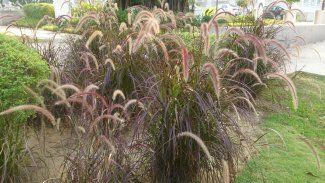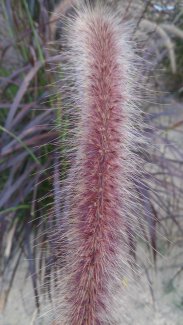For P. advena: probable origin paleotropics. Pennisetum × advena is thought to be a cross of P. setaceum, native to Northern Africa, and Pennisetum macrostachys (Brongn.) Trin., native to Malesia ( Wipff and Veldkamp, 1999). Both parents are from tropical regions, and purple fountain grass is said to be cold-hardy only to USDA hardiness zone 9
A clumping semi-evergreen grass that grows upright to 4-5+ feet tall with dark burgundy-red foliage that arches gracefully outwards and produces one foot long red plume-like inflorescences that rise above the foliage and arch over nicely toward the tips. This grass seems to be completely evergreen (red) in frost free zones, but goes deciduous with frost and it is root hardy to about 20° F and useful as a perennial in USDA Zones 9-10 and as an annual in colder areas.
HABIT Perennial; caespitose. Culms erect; 100–150 cm long. Culm-nodes glabrous. Lateral branches lacking, or sparse. Leaf-sheaths glabrous on surface; outer margin hairy. Ligule a ciliolate membrane; 0.5–0.8 mm long. Leaf-blades 33–52 cm long; 6–11 mm wide; purple. Leaf-blade margins scabrous; ciliate; hairy at base.
INFLORESCENCE Inflorescence a panicle. Panicle spiciform; linear; nodding; flexuous; 23–32 cm long; 3–5.8 cm wide. Primary panicle branches accrescent to a central axis; with sessile scars on axis. Panicle axis with rounded ribs; pubescent; bearing deciduous spikelet clusters. Spikelets subtended by an involucre. Fertile spikelets sessile and pedicelled; 1–3 in the cluster. Involucre composed of bristles; 11.7–25 mm long; base obtuse; base 0.5–1.1 mm long. Involucral bristles deciduous with the fertile spikelets; numerous; with an outer whorl of thinner bristles; 45–80 in principal whorl; inner bristles longer than outer; with one conspicuously longer bristle; 21.3–33.6 mm long; terete; flexible; ciliate.
SPIKELETS Spikelets comprising 1 basal sterile florets; 1 fertile florets; without rhachilla extension. Spikelets lanceolate; dorsally compressed; 5.3–6.5 mm long; falling entire; deciduous with accessory branch structures.
FLORETS Basal sterile florets male; with palea. Lemma of lower sterile floret elliptic; 4.7–6.1 mm long; 0.9 length of spikelet; chartaceous; 5 -veined; acuminate.
FLOWER Anthers 3; 2.5–2.7 mm long.
For P. advena: cultivated in North America. There's been a recent change in the correct taxonomy of this plant- it is now correctly classified as Pennisetum x advena, a cross between P. setaceum and P. macrostachys.
Per San Marcos Growers: For many years most nurseries and references have listed this plant as a variety of Pennisetum setaceum, either 'Rubrum' or 'Cupreum'. While it superficially resembles Pennisetum setaceum, a declared noxious weed in the western US, this plant has in the past also been described by some grass taxonomists as being a selection of the more tropical Pennisetum macrostachys. In the grass section of the Flora of North America, which includes naturalized and cultivated grasses, the specific name it is listed as in now Pennisetum advena . Dr. Joseph K. Wipff, previously with Texas A&M and now a turfgrass breeder, wrote the section on Pennisetum in the Flora of North America and has indicated that Red Fountain Grass is most likely a cross between Pennisetum setaceum and P. macrostachys and as a hybrid the name most appropriately be Pennisetum x advena 'Rubrum' and this is how we have listed this plant. The Latin word 'advena' means "newly arrived" or "stranger". Pennisetum 'Rubrum', nor selections made from it such as the variegated clone 'Fireworks', should really not be listed as a cultivar of Pennisetum setaceum as this is not only incorrect, but it would also confuses these plant with Pennisetum setaceum, a known noxious weed. In California and several other states where Pennisetum setaceum is a declared noxious weed it is actually not legal for nurseries to grow this species. In California it currently it has a C rating with the California Department of Food and Agriculture, meaning it must be controlled in nurseries. Organizations such as PlantRight and many others are rightfully advocating that it not be grown at all so it is an important distinction that the non-weedy hybrid cultivars not be mistaken for this species. We have grown Pennisetum 'Rubrum' at our nursery since 1982 and until 2006 also listed it as a cultivar of Pennisetum setaceum but have since corrected this.

